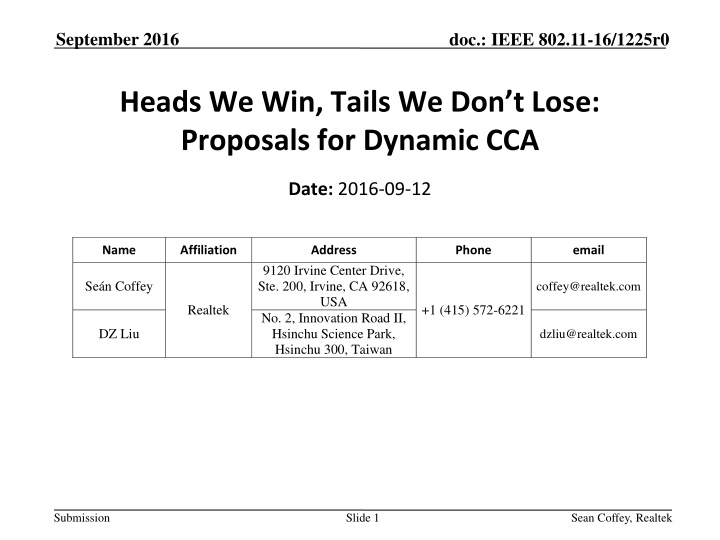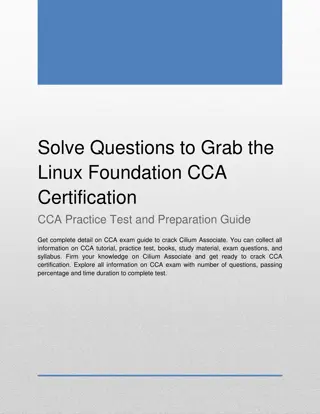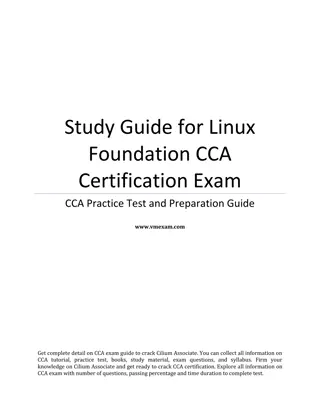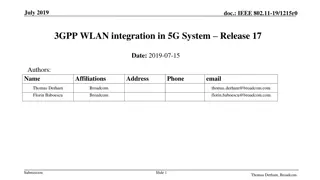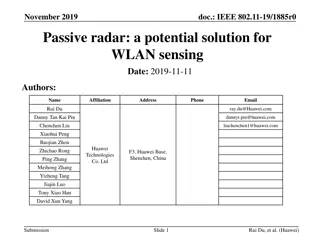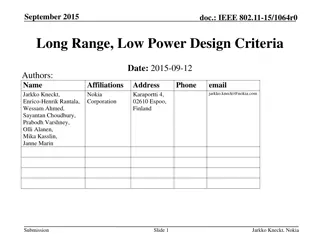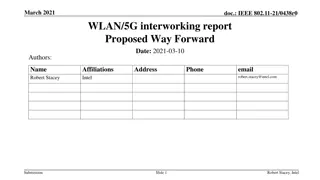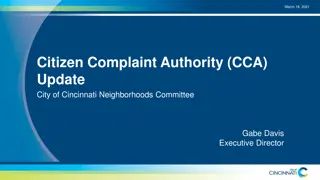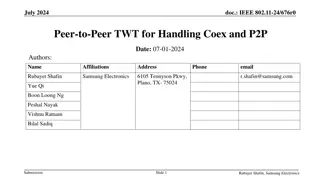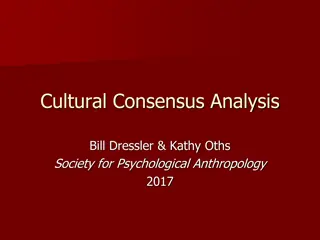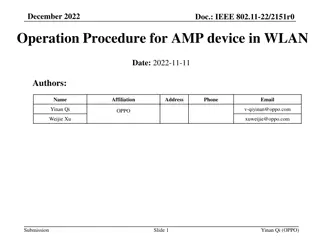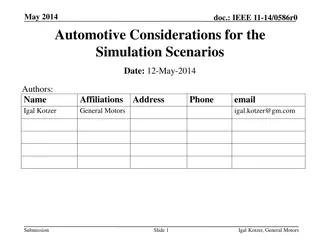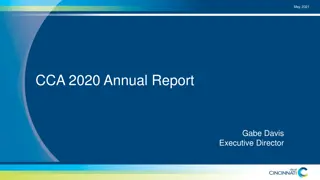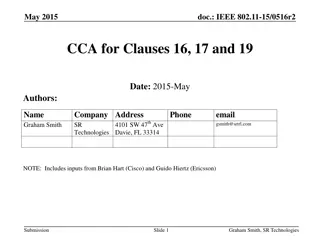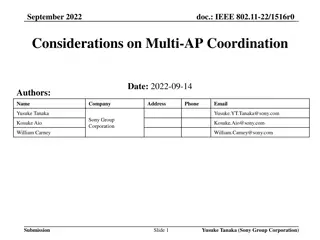Proposing Dynamic CCA Control for Performance Optimization in WLAN
This presentation discusses the variability in dynamic CCA performance in WLANs and proposes a protocol control mechanism to maximize benefits and minimize drawbacks. It emphasizes the need for an effective control to navigate differing configurations and achieve system throughput improvements without compromising stability. The speaker highlights the intricacies of altering CCA levels and their ripple effects on overall performance, calling for a thoughtful approach to protocol design. The presentation showcases simulations and case studies to underscore the importance of implementing a dynamic CCA mechanism in WLAN standards.
Download Presentation

Please find below an Image/Link to download the presentation.
The content on the website is provided AS IS for your information and personal use only. It may not be sold, licensed, or shared on other websites without obtaining consent from the author.If you encounter any issues during the download, it is possible that the publisher has removed the file from their server.
You are allowed to download the files provided on this website for personal or commercial use, subject to the condition that they are used lawfully. All files are the property of their respective owners.
The content on the website is provided AS IS for your information and personal use only. It may not be sold, licensed, or shared on other websites without obtaining consent from the author.
E N D
Presentation Transcript
September 2016 doc.: IEEE 802.11-16/1225r0 Heads We Win, Tails We Don t Lose: Proposals for Dynamic CCA Date: 2016-09-12 Name Affiliation Address Phone email 9120 Irvine Center Drive, Ste. 200, Irvine, CA 92618, USA No. 2, Innovation Road II, Hsinchu Science Park, Hsinchu 300, Taiwan Se n Coffey coffey@realtek.com Realtek +1 (415) 572-6221 DZ Liu dzliu@realtek.com Submission Slide 1 Sean Coffey, Realtek
September 2016 doc.: IEEE 802.11-16/1225r0 Abstract Dynamic CCA performance is known to vary widely depending on device configuration. In many cases parameters that improve performance in one configuration make matters worse (sometimes much worse) in many others. This presentation argues that the mode is worth the trouble of including it, and that we can achieve the upside while avoiding (most of) the downside, provided we have an effective protocol control. This presentation also proposes such a protocol control. Submission Slide 2 Sean Coffey, Realtek
September 2016 doc.: IEEE 802.11-16/1225r0 Statement of goals A basic ax goal is to improve system throughput Simulations involve random drops and result in averages across a great many configurations It s difficult to analyze any given mode to isolate its strengths and weaknesses and thereby improve the mode It doesn t correspond to how we usually think of WLAN E.g., 256-QAM: a 33% increase in date rate but only usable about 4% of the time under random drops, so < 1.5% increase overall no good An even more basic goal A mode that produces significant and predictable gains in common and easily understandable conditions, and that doesn t make matters worse in other conditions, is worth including in the spec Submission Slide 3 Sean Coffey, Realtek
September 2016 doc.: IEEE 802.11-16/1225r0 Performance of Dynamic CCA The effects of altering CCA levels ripple far beyond any given device pair and generate complicated consequences Effects of changing the CCA levels are highly scenario and parameters dependent [1, slide 11] The smooth curves seen on simulations of total or average throughput get much more complicated when you look at individual BSSs [2, slide 2] Cf. multi-company calibration of very simple, favorable case generating a wide range of results, no clear convergence [3, 4] Interpretation There have been enough presentations to enable interpretations Next few slides review and add new observations Submission Slide 4 Sean Coffey, Realtek
September 2016 doc.: IEEE 802.11-16/1225r0 Performance of Dynamic CCA I A favorable scenario: 50.2 m AP1 AP2 3.35 m 3.35 m 35.6 m STA1 STA2 5 GHz, 80 MHz channel MCS 7 (64-QAM, rate 5/6) Other assumptions as in [3, 4] Submission Slide 5 Sean Coffey, Realtek
September 2016 doc.: IEEE 802.11-16/1225r0 Performance of Dynamic CCA I, contd. A favorable scenario: 50.2 m 44.3 dBm SNR 50.7 dB 76 dBm AP1 AP2 3.35 m 3.35 m 35.6 m STA1 STA2 75 dBm +15 dBm Noise floor = 95 dBm CCAT current = 76 dBm (Noise figure = 0 dB) STA2 not permitted to transmit under current rules STA2 permitted to transmit if CCAT raised Submission Slide 6 Sean Coffey, Realtek
September 2016 doc.: IEEE 802.11-16/1225r0 Performance of Dynamic CCA I, contd. A favorable scenario: 50.2 m 44.3 dBm / 76 dBm 76 dBm / 44.3 dBm AP1 AP2 SINR 31.7 dB SINR 31.7 dB 3.35 m 3.35 m 35.6 m STA1 STA2 +15 dBm +15 dBm Under relaxed CCAT, STA2 may transmit Both AP1 and AP2 see SINR of 31.7 dB, much greater than the needed 20.4 dB [5] So both transmissions are successful 2x improvement (though TPC gets same) Submission Slide 7 Sean Coffey, Realtek
September 2016 doc.: IEEE 802.11-16/1225r0 Comments I SINR vs. SNR Usually SINR is compared directly to AWGN curves Too optimistic: interference varies in frequency domain and over time, and arrives on frequency-selective channel Performance is disproportionally influenced by worst-case SINR over tones and time, which may be 5+ dB worse than average In this example there s enough margin that it probably still works However if both transmitted MCS 9 (requiring 25.0 dB in AWGN), then with extra cost of SINR v. SNR, plus implementation losses, it would be unlikely to work Submission Slide 8 Sean Coffey, Realtek
September 2016 doc.: IEEE 802.11-16/1225r0 Comments II Effect of mid-packet interference STA1 Preamble Data STA2 STA2 remains subject to EDCA and can t transmit immediately on detecting STA1 s BSS Color Delayed start means channel estimates at AP1 will be incorrect In general, will cause some more performance loss If AP1 detects very high SNR on all tones, it could clip its estimates to minimum required to process that MCS, providing safety margin But probably not safe to assume that legacy devices all do this Submission Slide 9 Sean Coffey, Realtek
September 2016 doc.: IEEE 802.11-16/1225r0 Performance of Dynamic CCA II A less favorable scenario: 50.2 m 63 dBm AP1 AP2 SNR 32 dB 3.35 m 11.9 m STA2 35.6 m Wall STA1 STA1 to AP1 now D-NLOS Otherwise same assumptions MCS7 operating point 31.5 dB [6] STA1-AP1 can support MCS7 +15 dBm Submission Slide 10 Sean Coffey, Realtek
September 2016 doc.: IEEE 802.11-16/1225r0 Performance of Dynamic CCA II, contd. A less favorable scenario: 63 dBm AP1 AP2 SINR 13 dB 3.35 m 11.9 m STA2 35.6 m +15 dBm Wall STA1 STA2 sees same RSSI as before But SINR at AP1 drops to 13 dB STA1-AP1 now supports MCS0 +15 dBm Submission Slide 11 Sean Coffey, Realtek
September 2016 doc.: IEEE 802.11-16/1225r0 Performance of Dynamic CCA II, contd. An even less favorable scenario: 63 dBm AP1 AP2 SINR 13 dB 11.9 m 11.9 m Wall Wall 35.6 m STA2 STA1 +15 dBm +15 dBm Both MCS0 simultaneously, instead each MCS7 alternating 5x lower data rate Submission Slide 12 Sean Coffey, Realtek
September 2016 doc.: IEEE 802.11-16/1225r0 Comments III RSSI is not enough Here STA2 sees exactly the same RSSI from both STA1 and AP1, and it s still not enough: STA2 lacks information about the link between STA1 and AP1 The current baseline does not provide a safe harbor Current baseline permits transmission by STA2 (in effect) if interference at STA1 is 76 dBm or less This doesn t mean it has no effect: even the (better) reducing interference at AP1 to 76 dBm or less reduces the SINR by 20 dB + Relying on TPC to reduce interference at other receivers to 76 dBm significantly increases that interference (many interferers at exactly 76 dBm, whereas currently that s an improbable worst case) Submission Slide 13 Sean Coffey, Realtek
September 2016 doc.: IEEE 802.11-16/1225r0 Comments IV Sources of Dynamic CCA gain (when there s a gain) Difference in interference measured at Tx and at Rx CCAT deals with Tx, whereas what matters is Rx (If no interferers) Excess Rx RSSI beyond that needed for highest MCS With no excess, a 20+ dB jump in SINR reduces link to lowest MCS MIMO, 256-QAM, 1024-QAM reduce Dynamic CCA gains [7] (With interferers) SINR, MCS caused by new transmission With other interferers, new transmission may cause small SINR MCS of ongoing transmission determined by presence of other interferers Even if no other interferers in one individual packet In effect the other interferers may cap the highest MCS So Dynamic CCA is more likely to contribute a gain in dense deployments with many OBSSs, where there are already several interferers Submission Slide 14 Sean Coffey, Realtek
September 2016 doc.: IEEE 802.11-16/1225r0 Another use case Sketch of scenario: AP1 AP2 STA Managed deployment Multiple APs, part of same ESS, mutually isolated Simultaneous UL works if CCAT increased, to any level (not achievable with TPC) Submission Slide 15 Sean Coffey, Realtek
September 2016 doc.: IEEE 802.11-16/1225r0 Comments V Is Dynamic CCA worth it? The gains in the right circumstances are significant (even with caveats): ordinarily that would be enough Unlike ordinary modes, though, it causes significant losses in the wrong circumstances and they re not self-correcting The key is harvesting the gains without suffering the losses Predominantly a protocol issue: measuring RSSIs only takes us so far Submission Slide 16 Sean Coffey, Realtek
September 2016 doc.: IEEE 802.11-16/1225r0 Comments VI Protocol considerations It must be possible to turn Dynamic CCA off Enables network diagnostics, on/off comparisons, first do no harm Already in spec, though conditions completely TBD There must be some incentive to turn Dynamic CCA on TPC model is not sufficient TPC is already included but is hardly used On / off choice must be configurable per device The protocol must avoid hard choices An optimal protocol involves many tradeoffs between different BSSs; mean v. 5% outage throughputs; high data rate v. long range; ax v. ac/n/g It has been difficult for Wi-Fi to make such tradeoffs in the past Cf. the extreme difficulty even in deprecating 1 Mbps modes Submission Slide 17 Sean Coffey, Realtek
September 2016 doc.: IEEE 802.11-16/1225r0 Proposed approach I Interferee-based signalling Each packet indicates whether other devices may use relaxed CCAT with respect to that packet If no such signalling present, Dynamic CCA may not be used Interferee AP makes permission decision A non-AP STA may only disallow Dynamic CCA if permitted by its AP That AP has sole discretion on granting such permission Permission is per-STA and for limited duration Signaled and acknowledged per STA; valid for 100 (say) successful Tx s Protocol only specifies permission Both interfere and prospective interferer may choose default CCAT, whatever permissions are assigned Submission Slide 18 Sean Coffey, Realtek
September 2016 doc.: IEEE 802.11-16/1225r0 Proposed approach II Protocol outline, restated: (1) each ax PPDU contains an SR Allowed bit (2) if SR Allowed = 0, all devices (from any BSS) that decode that preamble successfully must use current CCAT for that PPDU ( 82 dBm for 20 MHz, etc.) Similarly if SR Allowed bit not present, e.g., legacy (3) if SR Allowed = 1, all devices (from any BSS) that decode that preamble successfully may use ax Dynamic CCA for that PPDU (4) non-AP STAs may only set SR Allowed = 0 in PPDUs they transmit if so permitted by their AP (4) all such permissions are for limited durations. Submission Slide 19 Sean Coffey, Realtek
September 2016 doc.: IEEE 802.11-16/1225r0 Summary Dynamic CCA performance Brings significant gains but in limited circumstances Increases overall interference levels Has greater impact on legacy receivers, depending on design May have more potential in managed environments Brings significant losses in other circumstances not self-correcting and pits different BSSs against each other Potential interferer does not have enough information to determine impact on interferee RSSIs are not enough even if potential interferer RSSIs at interferee Tx and interferee Rx are known Protocol Interferee AP controls guarantees acceptable results Submission Slide 20 Sean Coffey, Realtek
September 2016 doc.: IEEE 802.11-16/1225r0 References [1] IEEE doc. 11/14-1119r1, Effect of CCA in residential scenario part 2 , G. Barriac (Qualcomm) et al., September 2014 [2] IEEE doc. 11/15-0357r4, 802.11ax scenario 1 CCA , K. Odman (Broadcom), March 2015 [3] IEEE doc. 11/15-0652r1, Reference Simulation Model for Dynamic CCA / DSC Calibration , M. Mori (Sony) et al, May 2015 [4] IEEE doc. 11/15-0801r0, DCCA/DSC Reference Simulation Results , M. Mori (Sony) et al., July 2015 [5] IEEE doc. 11/14-0571r12, 11ax Evaluation Methodology , R. Porat (Broadcom) et al., January 2016 [6] E. Perahia and R. Stacey, Next Generation Wireless LANs. Cambridge University Press 2008. [7] IEEE doc. 11/15-0050r0, Modeling Components Impacting Throughput Gain from CCAT Adjustment , Y. Wang (Ericsson) et al., January 2015 [8] IEEE doc. 11/14-0872r0, A Protocol Framework for Dynamic CCA, S. Coffey (Realtek) et al., July 2014 Submission Slide 21 Sean Coffey, Realtek
